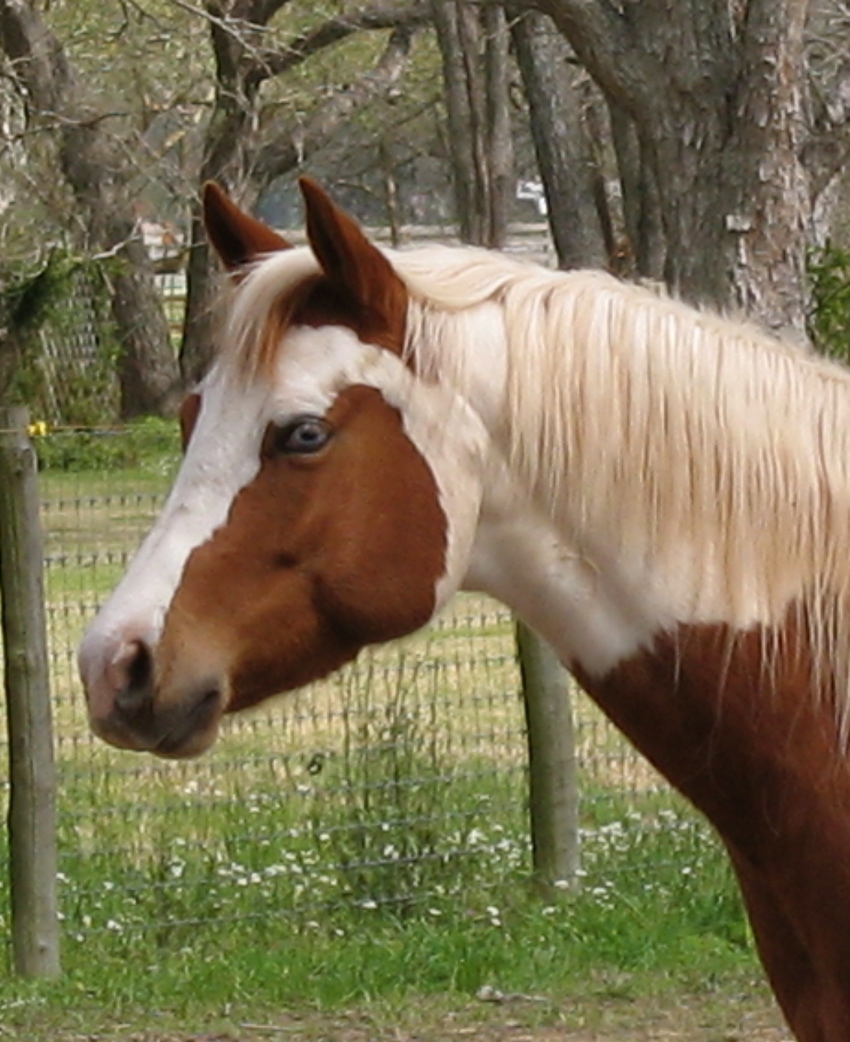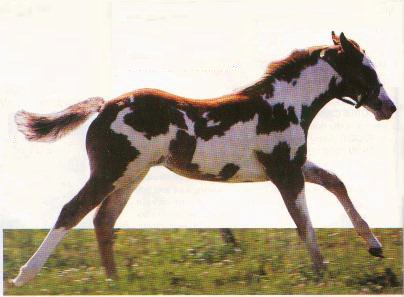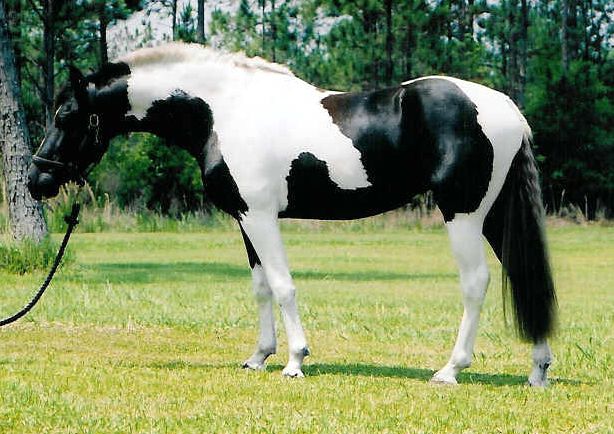Pinto Horse Pictures Definition
Source(Google.com
A pinto horse has a coat color that consists of large patches of white and any other color. The distinction between "pinto" and "solid" can be tenuous, as so-called "solid" horses frequently have areas of white hair. Various cultures throughout history appear to have selectively bred for pinto patterns.
Many breeds of horse carry pinto patterns. Pinto coloring, known simply as "coloured" in nations using British English, is most popular in the United States. While pinto colored horses are not a "breed," several competing color breed registries have formed to encourage the breeding of pinto-colored horses.
Pinto patterns are visually and genetically distinct from the leopard complex spotting patterns characteristic of horses such as the Appaloosa. Breeders who select for color are often careful not to cross the two patterns, and registries that include spotting color preferences often will refuse registration to horses who exhibit characteristics of the "wrong" pattern.
Origins
Although pinto coloration is rare in the wild, people have always had an eye for animals of unusual colors and a desire to deliberately breed for them. Images from pottery and other art of ancient antiquity show horses with flashy spotted patterns. Images of spotted horses appear in the art of Ancient Egypt, and archaeologists have found evidence of horses with spotted coat patterns on the Russian steppes before the rise of the Roman Empire. Later, spotted horses were among those brought to the Americas by the Conquistadors.
By the 17th century in Europe, spotted horses were quite fashionable, though when the fad ended, large numbers of newly-unsellable horses were shipped to the Americas, some for sale, and others simply turned loose to run wild.[1] The color became popular, particularly among Native Americans, and was specifically bred for in the United States, which now has the greatest number of pinto horses in the world.
The word "pinto" is a Spanish word literally meaning 'painted' and also 'dappled' or 'spotted'.[2
Color patterns and genetics of pinto horses
Main articles: Equine coat color, Equine coat color genetics, and leucism
There are a number of words which describe the various color and spotting patterns of pinto horses. Essentially, a pinto horse is genetically created when an allele for a spotting pattern is present. The genes that create the underlying base coat color are not related to the genes that create white spotting. The precise mechanisms that create spotting are not all fully understood, but those that are known often have human parallels, such as piebaldism. What horse terminology describes as "pinto" or "coloured" has been called leucism or "partial albinism" by pigment researchers. Common terms for describing different types of pinto horses include:
Colors
Piebald: (term more commonly used in nations using British English). Any pinto pattern on a black base coat, thus a black-and-white spotted horse.
Skewbald: (term more commonly used in nations using British English). Any pinto pattern on any base coat other than black. As chestnut and bay are the most common base coat colors, skewbalds are most often chestnut and white or bay and white. At one time, the term may have applied more specifically to brown-looking pinto horses, but today it encompasses any color other than black.
Coloured: The term for pinto coloration in nations using British English, including both piebald and skewbald.
Tricolored or Tricoloured: a term for horse with three colors (usually bay and white), in nations using British English. It is usually incorporated into the term skewbald.
Patterns
Tobiano: The most common type of pinto, tobiano is a spotting pattern characterized by rounded markings with white legs and white across the back between the withers and the dock of the tail, usually arranged in a roughly vertical pattern and more white than dark, though the ideal is a 50-50 distribution, with the head usually dark, having markings also seen on a non-pinto horse. i.e. star, snip, strip, or blaze. Tobiano is a simple dominant trait caused by a single gene and therefore all tobiano horses have at least one tobiano parent.[3] A DNA test exists for tobiano. Tobiano is not associated with any health concerns.
Overo: A collective term used primarily by the American Paint Horse Association (APHA), overo essentially means "pinto, but not tobiano." It denotes patterns produced by at least three different genetic mechanisms: frame, splashed white or sabino, described below. These patterns are usually characterized by irregular markings with more jagged edges than tobiano markings. The white rarely crosses the back. While some currently-identified overo patterns appear to be dominant or incomplete dominant traits, overo-patterned foals (called "cropouts") are occasionally produced from two apparently solid-colored parents.
Frame or frame overo: Frame is a popular and easily recognized type of non-tobiano pinto. This spotting pattern, in the absence of genes for other patterns, is characterized by horizontally-oriented white patches with jagged, crisp edges. White patches typically include the head, face and lateral aspects of the neck and body, and the eyes can be blue. Frame overos may have very modest markings that are not obviously "pinto." This quality allows the pattern to seemingly "hide" for generations, and is thought to be responsible for some cases of "cropouts." Frame is an incomplete dominant trait for which there is a DNA test; those without any copies of the "frame gene" (N/N) will not possess this pattern, while those with a single copy (N/O) usually exhibit frame patterning (though sometimes in a very minimal form). However, foals born with two copies (O/O) have lethal white syndrome and die shortly after birth. N/O frame horses do not have any known health defects, but have a 25% chance of producing lethal white foals if bred to another N/O horse.
Splashed white: A less-common type of non-tobiano pinto pattern, splashed white coats have horizontally-oriented white markings with crisp, smooth edges and make the horse appear to have been dipped, head lowered, into white paint. The face has significant white markings, and the eyes are usually blue. Most splashed white pintos have normal hearing, but the trait is linked to congenital deafness. In Europe, some patterns identified as sabino in the USA are called "splash," particularly in the Icelandic horse.
Sabino: Sometimes confused with roan or rabicano, sabino horses possess a slight spotting pattern characterized by high white on legs, belly spots, and white markings on the face extending past the eyes. The edges of markings may be "lacy" or there can be patches of roaning patterns standing alone or on the edges of white markings. Some forms of the sabino phenotype are thought to be polygenic or a gene complex. However, one form for which there is a DNA test, the sabino-1 (SB1) gene, is a dominant. Horses homozygous for SB-1 are often completely white. Sabino-1 and other sabino patterns are not associated with any health defects. Though genetically unrelated to frame or splash, sabino is classified with the "overo" family of patterns by the APHA. Sabino is not necessarily classified as an overo pattern by other breed registries, particularly those whose horses do not carry the genes for other pinto patterns.
Tovero: The tovero spotting pattern is a mix of tobiano and any form of overo coloration, usually reflecting that the horse carries more than one set of genes for a spotting pattern. For example, a tovero may have a mostly white tobiano pattern on the body, but also have blue eyes with or without a white head. Horses can carry multiple spotting genes at the same time, producing characteristics of several patterns.
Dominant white: A family of sabino-like white spotting patterns, all dominant white coats are dominantly inherited, analogous to human piebaldism. While some forms are associated with pure white coats and are considered "true white," not pinto, most actually show great variance in the amount of white. The 11 known forms of dominant white have all occurred spontaneously in the past century from non-white parents. Many forms of white spotting that were called "sabino" by their owners and fanciers are now classified as dominant white. The distinction between sabino and dominant white is unclear, as they are visually similar and involve closely related genes.







Source(Google.com
A pinto horse has a coat color that consists of large patches of white and any other color. The distinction between "pinto" and "solid" can be tenuous, as so-called "solid" horses frequently have areas of white hair. Various cultures throughout history appear to have selectively bred for pinto patterns.
Many breeds of horse carry pinto patterns. Pinto coloring, known simply as "coloured" in nations using British English, is most popular in the United States. While pinto colored horses are not a "breed," several competing color breed registries have formed to encourage the breeding of pinto-colored horses.
Pinto patterns are visually and genetically distinct from the leopard complex spotting patterns characteristic of horses such as the Appaloosa. Breeders who select for color are often careful not to cross the two patterns, and registries that include spotting color preferences often will refuse registration to horses who exhibit characteristics of the "wrong" pattern.
Origins
Although pinto coloration is rare in the wild, people have always had an eye for animals of unusual colors and a desire to deliberately breed for them. Images from pottery and other art of ancient antiquity show horses with flashy spotted patterns. Images of spotted horses appear in the art of Ancient Egypt, and archaeologists have found evidence of horses with spotted coat patterns on the Russian steppes before the rise of the Roman Empire. Later, spotted horses were among those brought to the Americas by the Conquistadors.
By the 17th century in Europe, spotted horses were quite fashionable, though when the fad ended, large numbers of newly-unsellable horses were shipped to the Americas, some for sale, and others simply turned loose to run wild.[1] The color became popular, particularly among Native Americans, and was specifically bred for in the United States, which now has the greatest number of pinto horses in the world.
The word "pinto" is a Spanish word literally meaning 'painted' and also 'dappled' or 'spotted'.[2
Color patterns and genetics of pinto horses
Main articles: Equine coat color, Equine coat color genetics, and leucism
There are a number of words which describe the various color and spotting patterns of pinto horses. Essentially, a pinto horse is genetically created when an allele for a spotting pattern is present. The genes that create the underlying base coat color are not related to the genes that create white spotting. The precise mechanisms that create spotting are not all fully understood, but those that are known often have human parallels, such as piebaldism. What horse terminology describes as "pinto" or "coloured" has been called leucism or "partial albinism" by pigment researchers. Common terms for describing different types of pinto horses include:
Colors
Piebald: (term more commonly used in nations using British English). Any pinto pattern on a black base coat, thus a black-and-white spotted horse.
Skewbald: (term more commonly used in nations using British English). Any pinto pattern on any base coat other than black. As chestnut and bay are the most common base coat colors, skewbalds are most often chestnut and white or bay and white. At one time, the term may have applied more specifically to brown-looking pinto horses, but today it encompasses any color other than black.
Coloured: The term for pinto coloration in nations using British English, including both piebald and skewbald.
Tricolored or Tricoloured: a term for horse with three colors (usually bay and white), in nations using British English. It is usually incorporated into the term skewbald.
Patterns
Tobiano: The most common type of pinto, tobiano is a spotting pattern characterized by rounded markings with white legs and white across the back between the withers and the dock of the tail, usually arranged in a roughly vertical pattern and more white than dark, though the ideal is a 50-50 distribution, with the head usually dark, having markings also seen on a non-pinto horse. i.e. star, snip, strip, or blaze. Tobiano is a simple dominant trait caused by a single gene and therefore all tobiano horses have at least one tobiano parent.[3] A DNA test exists for tobiano. Tobiano is not associated with any health concerns.
Overo: A collective term used primarily by the American Paint Horse Association (APHA), overo essentially means "pinto, but not tobiano." It denotes patterns produced by at least three different genetic mechanisms: frame, splashed white or sabino, described below. These patterns are usually characterized by irregular markings with more jagged edges than tobiano markings. The white rarely crosses the back. While some currently-identified overo patterns appear to be dominant or incomplete dominant traits, overo-patterned foals (called "cropouts") are occasionally produced from two apparently solid-colored parents.
Frame or frame overo: Frame is a popular and easily recognized type of non-tobiano pinto. This spotting pattern, in the absence of genes for other patterns, is characterized by horizontally-oriented white patches with jagged, crisp edges. White patches typically include the head, face and lateral aspects of the neck and body, and the eyes can be blue. Frame overos may have very modest markings that are not obviously "pinto." This quality allows the pattern to seemingly "hide" for generations, and is thought to be responsible for some cases of "cropouts." Frame is an incomplete dominant trait for which there is a DNA test; those without any copies of the "frame gene" (N/N) will not possess this pattern, while those with a single copy (N/O) usually exhibit frame patterning (though sometimes in a very minimal form). However, foals born with two copies (O/O) have lethal white syndrome and die shortly after birth. N/O frame horses do not have any known health defects, but have a 25% chance of producing lethal white foals if bred to another N/O horse.
Splashed white: A less-common type of non-tobiano pinto pattern, splashed white coats have horizontally-oriented white markings with crisp, smooth edges and make the horse appear to have been dipped, head lowered, into white paint. The face has significant white markings, and the eyes are usually blue. Most splashed white pintos have normal hearing, but the trait is linked to congenital deafness. In Europe, some patterns identified as sabino in the USA are called "splash," particularly in the Icelandic horse.
Sabino: Sometimes confused with roan or rabicano, sabino horses possess a slight spotting pattern characterized by high white on legs, belly spots, and white markings on the face extending past the eyes. The edges of markings may be "lacy" or there can be patches of roaning patterns standing alone or on the edges of white markings. Some forms of the sabino phenotype are thought to be polygenic or a gene complex. However, one form for which there is a DNA test, the sabino-1 (SB1) gene, is a dominant. Horses homozygous for SB-1 are often completely white. Sabino-1 and other sabino patterns are not associated with any health defects. Though genetically unrelated to frame or splash, sabino is classified with the "overo" family of patterns by the APHA. Sabino is not necessarily classified as an overo pattern by other breed registries, particularly those whose horses do not carry the genes for other pinto patterns.
Tovero: The tovero spotting pattern is a mix of tobiano and any form of overo coloration, usually reflecting that the horse carries more than one set of genes for a spotting pattern. For example, a tovero may have a mostly white tobiano pattern on the body, but also have blue eyes with or without a white head. Horses can carry multiple spotting genes at the same time, producing characteristics of several patterns.
Dominant white: A family of sabino-like white spotting patterns, all dominant white coats are dominantly inherited, analogous to human piebaldism. While some forms are associated with pure white coats and are considered "true white," not pinto, most actually show great variance in the amount of white. The 11 known forms of dominant white have all occurred spontaneously in the past century from non-white parents. Many forms of white spotting that were called "sabino" by their owners and fanciers are now classified as dominant white. The distinction between sabino and dominant white is unclear, as they are visually similar and involve closely related genes.
Pinto Horse Pictures Images Wallpapers Photos 2013

Pinto Horse Pictures Images Wallpapers Photos 2013

Pinto Horse Pictures Images Wallpapers Photos 2013

Pinto Horse Pictures Images Wallpapers Photos 2013

Pinto Horse Pictures Images Wallpapers Photos 2013
Pinto Horse Pictures Images Wallpapers Photos 2013

Pinto Horse Pictures Images Wallpapers Photos 2013
Pinto Horse Pictures Images Wallpapers Photos 2013

Pinto Horse Pictures Images Wallpapers Photos 2013

Pinto Horse Pictures Images Wallpapers Photos 2013
Pinto Horse Pictures Images Wallpapers Photos 2013



No comments:
Post a Comment